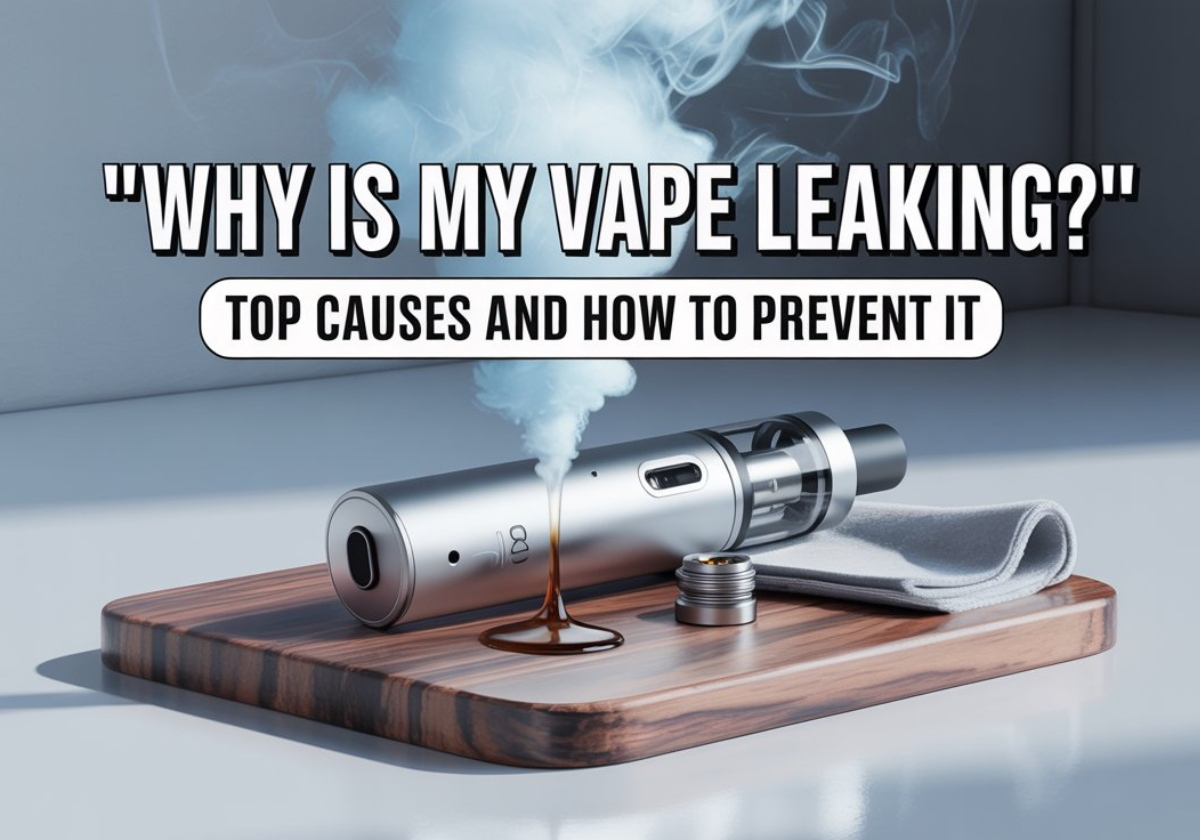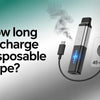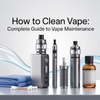Why Is My Vape Leaking? Top Causes and How to Prevent It

If you've ever pulled your vape out of your pocket only to find a sticky mess of e-liquid coating your hands, you're not alone. Vape leaking is one of the most frustrating issues vapers face, whether you're using a high-end mod or a simple disposable device. Not only does it waste your precious e-juice, but it also creates an annoying mess and can seriously impact your overall vaping experience.
The good news? Most leaking problems are preventable once you understand what's causing them. In this guide, we'll walk through the common reasons why vapes leak, how to fix a leaking vape when it happens, and practical tips to prevent it from becoming a recurring headache. Whether you're wondering "why is my Geek Vape leaking" or dealing with vape leaking from the bottom, we've got you covered.
Understanding Why Your Vape Leaks
What Does Vape Leakage Mean?
Vape leakage happens when e-liquid escapes from places it shouldn't—typically through the airflow holes, mouthpiece, or from the bottom of your tank. It's important to distinguish between actual leaking and normal condensation. A small amount of moisture around the mouthpiece after a long vaping session is usually just condensation and nothing to worry about.
Real leakage, on the other hand, involves noticeable amounts of e-liquid pooling in your device, seeping through airflow holes, or creating a sticky residue on the outside of your vape.
You might notice vape juice leakage when you pick up your device after it's been sitting idle, or sometimes even while you're actively using it. The liquid might drip from the airflow, collect at the base of the tank, or worse, find its way into your mouth during a draw — especially with rich, flavorful strains like Granddaddy Purple Vape, which can make leaks even more noticeable due to its thicker, aromatic oil.
Understanding the difference between minor moisture buildup and genuine e-liquid leaking issues is the first step in addressing the problem effectively.
Which Vape Devices Leak the Most?
Not all vapes are created equal when it comes to leak resistance. Disposable vapes are generally designed to be leak-resistant since they're sealed units, though they're not completely immune to leaking—especially if exposed to temperature changes or stored improperly. When a disposable vape leaking occurs, it's often due to manufacturing defects or environmental factors.
Refillable pod systems and tank-style cheap vapes are more prone to leaks simply because they have more components that can fail or be improperly assembled. Tank-style devices with multiple O-rings, adjustable airflow, and replaceable coils offer more points where e-liquid can potentially escape.
That said, these devices also give you more control over maintenance and repairs, meaning most leaks are fixable with proper care and attention.
Common Causes of Vape Leaks
1. Overfilling the Vape Tank
One of the most common mistakes that leads to vape tank leakage is overfilling. Every vape tank has a maximum fill line for a reason. When you fill past this line, you don't leave enough room for air pressure to balance properly inside the tank. This pressure buildup forces e-liquid out through any available opening—usually the airflow holes or mouthpiece.
Think of it like filling a water bottle to the absolute brim and then trying to screw the cap on. The liquid has nowhere to go but out. Most tanks are designed with a small air pocket at the top that helps regulate pressure and allows the coil to wick properly.
When you overfill your tank, you eliminate this crucial space, creating a recipe for leaks. Always fill your tank to just below the maximum fill line, leaving that small gap at the top for proper airflow and pressure management.
2. Damaged or Misaligned O-Rings
O-rings are those small rubber seals you'll find throughout your vape device—around the tank's glass, at connection points, and inside the coil assembly. These tiny components play a huge role in preventing leaks by creating airtight seals between different parts of your device. When O-rings become damaged, dried out, stretched, or misaligned, they can't do their job properly, and e-liquid finds its way through the gaps.
Over time, O-rings naturally degrade from exposure to e-liquid, heat, and regular wear and tear. They might develop cracks, lose their elasticity, or simply get dislodged during cleaning or reassembly. Inspecting your O-rings regularly is essential for vape maintenance tips.
When you disassemble your vape for cleaning, check each O-ring for signs of damage or wear. They should feel pliable and sit snugly in their grooves. If they look dry, cracked, or stretched out, it's time for O-ring replacement. Most vape devices come with spare O-rings, and they're inexpensive to buy separately if needed.
3. Worn-Out Coils or Improper Installation
Vape coil problems are another leading cause of leaks. Your coil is the heart of your vaping device, and when it's not functioning properly or isn't installed correctly, you're likely to experience leaking. Coils have a limited lifespan—typically one to three weeks depending on how frequently you vape and what kind of e-liquid you use.
As coils age, the wicking material inside them becomes saturated with residue and loses its ability to absorb e-liquid efficiently. When this happens, excess liquid can flood the coil chamber and leak out.
Improper coil installation is equally problematic. If your coil isn't screwed in tightly enough, gaps form between the coil and the tank base, allowing e-liquid to seep through. On the flip side, over-tightening can damage the coil's threads or O-rings, which also leads to leaks — a common issue even with popular options like the Pineapple Express vape if not assembled correctly.
When installing a new coil, screw it in firmly but not forcefully—you should feel it snug up naturally. Also, make sure you're using coils that are compatible with your specific device. Using the wrong coil type can result in improper sealing and inevitable leaking.
4. Thin or Incorrect E-Liquid
The viscosity of your e-liquid plays a significant role in whether your vape will leak. E-liquids contain different ratios of Propylene Glycol (PG) and Vegetable Glycerin (VG). PG is thinner and more fluid, while VG is thicker and more viscous. If you're using an e-liquid with a high PG ratio in a device designed for thicker liquids, you're essentially asking for trouble.
Thin e-liquids flow more easily through the wicking material and can saturate your coil too quickly, leading to flooding and leaking. This is especially true for sub-ohm tanks and high-powered devices that need thicker liquids to keep up with their wicking capabilities. For most modern tank systems, e-liquids with a VG content of 60% or higher work best for vape juice leakage prevention.
Pod systems and mouth-to-lung devices, on the other hand, often work better with 50/50 or slightly higher PG ratios. Always check your device's specifications to ensure you're using the right e-liquid consistency for optimal performance.

5. Temperature and Pressure Changes
Have you noticed your vape leaking when not in use, especially after leaving it in your car on a hot day or taking it on a plane? That's because e-liquid behaves differently under varying temperature and pressure conditions. Heat causes e-liquid to thin out and become more fluid, making it more likely to seep through any available opening. In hot environments, the air inside your tank expands, creating additional pressure that can force liquid out through the airflow holes.
Vape tank pressure issues become even more pronounced during air travel or driving through different altitudes. As cabin pressure changes or you ascend a mountain road, the air pressure inside your tank doesn't adjust at the same rate as the external environment. This pressure differential pushes e-liquid out wherever it can escape.
To minimize these issues, try to keep your vape stored in a temperature-controlled environment. If you're flying or know you'll be in a hot car, consider emptying your tank partially or storing your device upright in a sealed bag to contain any potential leaks.
6. Inhalation Technique
Believe it or not, how you draw on your vape can actually contribute to leaking. Pulling too hard on your device creates excessive negative pressure inside the tank, which can pull more e-liquid into the coil chamber than it can handle. This flooding leads to gurgling, spitting, and eventually leaking through the airflow or mouthpiece.
On the other hand, taking extremely gentle puffs might not generate enough airflow to properly vaporize the e-liquid, leading to condensation buildup that eventually drips out.
The type of draw your device is designed for also matters. Mouth-to-lung (MTL) devices require gentler, cigarette-style draws, while direct-lung (DL) devices need stronger, longer inhales. Using the wrong inhalation technique for your device type disrupts the airflow balance and can result in a leaking vape cartridge or tank.
Try to find that sweet spot—a steady, moderate draw that produces good vapor without creating excessive pressure or condensation. If you're using a Blue Dream vape and experiencing leaking alongside gurgling sounds, your inhalation technique might need adjusting.
7. Cracks or Damage in the Tank
Physical damage to your vape tank is sometimes the culprit behind persistent leaks. Even tiny micro-cracks in the glass or plastic tank can allow e-liquid to escape gradually. These cracks aren't always obvious—they might be hairline fractures that only become visible when you hold the tank up to the light or apply slight pressure.
Dropping your vape, keeping it in a bag with keys or other hard objects, or simply using an older device with worn components can all lead to tank damage.
Pay special attention to the tank's glass when you clean your device. Run your finger around the seams where the glass meets the metal base and top cap. Any roughness, gaps, or irregularities could indicate vape seal damage. If you notice any cracks, no matter how small, it's time to replace the glass or the entire tank.
Many vape manufacturers sell replacement glass separately, which is much more affordable than buying a whole new device. Regular inspections as part of your vape maintenance routine can catch these issues before they turn into major leaking problems.
8. Faulty Airflow Design or Settings
The airflow system in your vape does more than just control the vapor production and draw resistance—it also plays a role in preventing leaks. When your airflow is set too loose or if the airflow ring isn't properly aligned, e-liquid can escape through these openings. Some vapers experience vape leaking through airflow holes specifically because their airflow control isn't properly closed when the device is not in use.
Here's a helpful tip: when you're not actively vaping, especially if you're storing your device in your pocket or bag, close the airflow control or at least reduce it significantly. This minimizes the openings through which e-liquid can escape. Additionally, make sure your airflow ring is properly aligned with your device.
Some tanks have adjustable airflow that can be accidentally rotated, creating gaps where e-liquid can seep through. After cleaning or reassembling your vape, always double-check that the airflow control is properly positioned and functioning as intended.
How to Fix a Leaking Vape
Step-by-Step Vape Leak Troubleshooting
When you discover your vape is leaking, don't panic. Most leaks can be fixed with some basic troubleshooting and a little patience. Here's how to fix a leaking vape systematically:

1. Disassemble your vape carefully: Start by removing the tank from the battery or mod. Then, carefully unscrew the base from the glass section and remove the coil. Empty any remaining e-liquid into a container—don't pour it down the sink as it can be harmful to the environment.
2. Clean the tank and connections with a dry cloth: Use a paper towel or lint-free cloth to wipe down all components. Pay special attention to the threading, connection points, and any areas where e-liquid has accumulated. For stubborn residue, you can use warm water, but make sure everything is completely dry before reassembly.
3. Inspect the coil, seals, and O-rings: Look closely at your coil to ensure it's not damaged or flooded. Check all O-rings for cracks, stretching, or misalignment. Make sure they're seated properly in their grooves. If any O-rings look compromised, replace them with fresh ones.
4. Reassemble firmly (avoid over-tightening): When putting your vape back together, screw the coil in first, making sure it's snug but not overly tight. Then attach the glass to the base, ensuring all O-rings are in place. Finally, screw the assembled tank back onto your device. Everything should feel secure, but you shouldn't have to force anything.
5. Test for airflow and pressure balance: Before refilling, close the airflow completely, then add your e-liquid to just below the maximum fill line. Let the coil prime for 5-10 minutes, then open the airflow and take a few gentle draws without firing the device to create proper pressure balance. This pulls e-liquid into the coil without flooding it.
How to Fix a Leaking Disposable Vape
Disposable vapes present a unique challenge because they're not designed to be opened or repaired. However, there are a few things you can try when dealing with a leaking e-cigarette of the disposable variety. If the leak is coming from the mouthpiece, it might just be condensation that you can wipe away with a tissue. Try gently tapping the device on a paper towel (mouthpiece down) to help any excess liquid drain out — the same quick fix often works for cheap carts that develop minor leaks.
Sometimes a disposable vape leaking issue stems from how you're storing or using it. Keep the device upright when not in use, and avoid leaving it in hot environments like your car dashboard. Take shorter, gentler puffs rather than long, hard draws that might flood the internal coil.
That said, if your disposable is leaking significantly from the bottom or through the airflow and cleaning doesn't help, it's probably best to replace it. Unlike refillable devices, disposables don't have replaceable components, so persistent leaks often indicate a manufacturing defect or internal damage that can't be fixed. Most reputable brands will replace defective disposables if you contact their customer service.
How to Prevent Your Vape from Leaking
Proper Filling and Storage Techniques
Prevention is always better than dealing with a mess, and proper filling and storage habits go a long way toward preventing vape leaks. When filling your tank or pod, take your time and don't rush. Hold the device at a slight angle and fill slowly, allowing the e-liquid to flow down the wall of the tank rather than directly onto the coil. Always stop at or slightly below the maximum fill line—that extra space at the top is crucial for pressure regulation.
Storage matters more than most people realize. Always store your vape upright when possible, especially overnight or during long periods of non-use. Laying your device on its side allows e-liquid to flow toward the airflow holes and mouthpiece, where it's more likely to leak out. If you're traveling or know you'll be in an environment with temperature fluctuations, consider storing your vape in a sealed plastic bag or case. This won't prevent leaking entirely, but it will contain any mess and protect your belongings.
In hot weather or pressurized environments like airplanes, the best way to store vape to avoid leaks is partially empty. If you're flying, try to use up most of your e-liquid before boarding, or empty your tank entirely and refill after you land. For long car trips in summer, keep your vape in a cooler area of the vehicle, away from direct sunlight. These simple storage adjustments can prevent most temperature and pressure-related leaking issues.
Use the Right E-Liquid for Your Device
Matching your e-liquid to your device type is crucial for preventing leaks. As mentioned earlier, the PG/VG ratio affects how the liquid flows through your coil. For sub-ohm tanks and high-wattage devices, stick with e-liquids that have at least 60-70% VG. These thicker liquids won't flow through your wicking material as quickly, reducing the chance of flooding and subsequent leaking.
For pod systems and MTL devices with higher resistance coils, a 50/50 PG/VG ratio or slightly higher PG content works better. These devices have smaller wicking ports that can actually struggle with liquids that are too thick, leading to dry hits. However, they also don't produce as much heat, so the thinner liquid won't become so fluid that it leaks excessively.
It's also worth investing in quality e-liquids from reputable manufacturers. Cheap or poorly made e-juices sometimes have inconsistent viscosity or contain additives that can affect how they perform in your device. They might also gunk up your coils faster, leading to premature coil failure and associated leaking problems. Whether you’re using regular vape juice or indica carts, quality products are a worthwhile investment that improve your vaping experience and help with vape juice leakage prevention.
Regular Cleaning and Maintenance
Establishing a regular cleaning routine is one of the most effective ways to prevent vape leaks before they start. Depending on how frequently you vape, aim to do a thorough cleaning of your tank every one to two weeks. This involves disassembling the tank completely, rinsing all components (except the coil) with warm water, and allowing everything to dry thoroughly before reassembly.
During these cleaning sessions, inspect all your O-rings and replace any that show signs of wear. Check your tank glass for cracks or scratches. Examine the threading on your device for any cross-threading damage or debris buildup. Clean the 510 connection (the threaded part that connects your tank to the battery) with a cotton swab to remove any e-liquid or lint that might interfere with a proper seal. If you’re using hybrid carts, make sure to clean both the cartridge and battery connection regularly to maintain smooth performance and consistent vapor quality.
Replace your coils on schedule, too. Most coils last 1-3 weeks depending on usage and e-liquid type. Don't wait until your coil is completely burnt out—by then, it's already affecting your vaping experience and possibly contributing to leaks. When you notice a decline in flavor or vapor production, or if you start experiencing gurgling, it's time for a fresh coil. Keeping spare coils, O-rings, and cleaning supplies on hand makes regular maintenance much easier and helps you stay ahead of potential leaking problems.
Properly Seal and Close Components
One of the simplest yet most overlooked aspects of preventing leaks is making sure everything is properly sealed and closed. After cleaning or refilling, take a moment to ensure every component is correctly assembled. Cross-threading is a common problem that happens when you start screwing parts together at a slight angle. This damages the threads and creates gaps where e-liquid can escape.
When assembling your tank or sativa carts, start by gently placing the threaded parts together and turning counter-clockwise (loosening direction) until you feel a slight click—this indicates the threads have aligned. Then turn clockwise to tighten, and the parts should screw together smoothly. If you feel resistance or if the parts aren't threading smoothly, stop and realign rather than forcing it.
Tightness is a balancing act. You want components snug enough to create proper seals, but not so tight that you damage O-rings or strip threads. If you have to really crank on something to get it tight, you're probably overdoing it. Everything should come together with moderate hand pressure. After reassembly, give each connection point a gentle check to ensure it's secure but not overtightened.
Vape-Specific Troubleshooting
Why Is My Geek Vape Leaking?
Geek Vape devices are popular for their durability and performance, but like any vape, they can still experience leaking if not properly maintained. Common issues with Geek Vape models often relate to their top-fill designs and high-performance sub-ohm tanks. When wondering "why is my Geek Vape leaking," start by checking the top-fill cap seal. These caps use silicone or rubber seals that can degrade over time or get debris lodged in them, preventing a complete seal.
For Geek Vape's sub-ohm tanks like the Zeus or Cerberus series, make sure you're using e-liquid with adequate VG content—at least 70% VG works best. These powerful tanks operate at higher temperatures and wattages, which means thinner liquids will heat up quickly and potentially flood the coil. Also, check that you're using the recommended wattage range for your specific coil. Running your device at too low a wattage won't vaporize the e-liquid efficiently, leading to flooding and leaks.
Another Geek Vape-specific tip: their coils often come with multiple O-rings pre-installed. When installing a new coil, make sure all these O-rings are present and properly positioned. It's easy to accidentally dislodge or lose one during installation. If your Geek Vape is persistently leaking from the base, disassemble everything and carefully inspect each O-ring, replacing any that look worn or damaged.
Why Is My Disposable Vape Leaking?
Disposable vape leaking is particularly frustrating because you can't really take the device apart to fix it. Most disposable vape leaks happen for a few specific reasons. Manufacturing defects, while relatively rare with reputable brands, do occasionally occur. If your disposable starts leaking immediately or very soon after you start using it, you likely got a dud. Contact the retailer or manufacturer for a replacement.
When assembling your tank, start by gently placing the threaded parts together and turning counter-clockwise (loosening direction) until you feel a slight click—this indicates the threads have aligned. Then turn clockwise to tighten, and the parts should screw together smoothly. If you feel resistance or if the parts aren't threading smoothly, stop and realign rather than forcing it. This simple care tip helps keep your Sour Diesel vape or any other device in perfect working condition for a smooth, hassle-free experience.
Altitude changes during air travel also cause disposable vapes to leak. The pressure difference between ground level and cruising altitude can force e-liquid out through the airflow holes. To minimize this, store your disposable upright in a sealed bag when flying. Some vapers find that taking a few puffs before and after takeoff helps equalize the pressure.
Finally, how you're using the device matters. Taking extremely long or hard draws can flood the internal coil, causing the excess e-liquid to leak out. Disposables are designed for moderate, cigarette-style puffs. If you treat them like a high-powered mod, you'll overwhelm the system. Gentle, 1-2 second draws work best for most disposable devices.
When to Replace Your Vape
Sometimes, despite your best efforts, a vape just reaches the end of its useful life. Knowing when to throw in the towel and invest in a new device can save you a lot of frustration and wasted e-liquid. Here are some signs that it's time for a replacement:
Persistent leaking despite all fixes: If you've tried everything—new coils, new O-rings, proper filling techniques, appropriate e-liquid—and your device still leaks constantly, the problem might be structural. Damaged threading, a warped tank, or internal issues that aren't visible can cause chronic leaking that's simply not worth fighting.
Visible cracks or damage: Any cracks in the tank glass, even small ones, will eventually lead to leaks. While replacement glass is available for many devices, if your tank is also showing other signs of wear, it might be more cost-effective to upgrade to a new device entirely.

Worn threading: If the threads on your tank or battery connection are stripped or damaged, you won't be able to create proper seals no matter what you do. This is especially common on older devices that have been assembled and disassembled many times.
Outdated technology: Vape technology has improved significantly in recent years. Modern devices feature better leak-proof designs, improved O-ring materials, and more reliable coil systems. If you're using an older device, upgrading to something newer might solve your leaking problems simply because the design is more refined.
When shopping for a new vape, look for devices with good reviews specifically mentioning leak resistance. Top-fill designs, quality O-rings, and reliable coil systems all contribute to a leak-free experience. Sometimes investing a bit more in a quality device upfront saves you money and hassle in the long run.
Final Thoughts
Dealing with a leaking vape doesn't have to be a constant battle. By understanding what causes vapes to leak—whether it's overfilling, damaged O-rings, improper e-liquid, temperature changes, or worn coils—you can take proactive steps to prevent most leaking issues before they start. Regular maintenance, proper filling and storage techniques, and using the right e-liquid for your Delta King device go a long way toward keeping your vape leak-free.
When leaks do occur, systematic troubleshooting usually identifies and resolves the problem quickly. Clean your device, inspect all seals and components, ensure everything is properly assembled, and make any necessary replacements. Most vape leaks are fixable with a few minutes of attention and basic maintenance.
Remember that your vaping experience should be enjoyable, not frustrating. A well-maintained device with quality components will serve you reliably and leak-free for a long time. Take care of your vape, and it'll take care of you. If you're consistently experiencing leaking issues despite proper care, it might be time to upgrade to a device with better leak-resistant design.
Looking for high-quality vape devices and accessories that are built to last? Invest in reliable equipment and take the time to learn proper maintenance—your device (and your pockets) will thank you.
FAQ
Is it safe to use a leaking vape?
Using a leaking vape isn’t ideal. Minor leaks aren’t dangerous, but if e-liquid seeps into the battery area, it could cause a short circuit. Fix the issue before continued use.
Why is vape liquid coming into my mouth?
This “spitback” happens when the coil floods or e-liquid is too thin. Clean the mouthpiece, use proper e-liquid, and take moderate draws to prevent it.
How to fix a leaking disposable vape?
Tap the vape mouthpiece-down on a paper towel to drain excess liquid. Keep it upright and take gentle puffs—if it still leaks, replace it.
Why is smoke coming out the bottom of my disposable vape?
That “smoke” is vapor from leaking e-liquid hitting the battery or coil. Stop using it immediately—it’s unsafe and should be replaced.
What causes vape leaks?
Leaks often stem from overfilling, worn O-rings, thin e-liquid, or temperature changes. Proper maintenance and correct e-liquid viscosity prevent most issues.
How do leaks affect vaping experience?
Leaks waste e-liquid, dull flavor, and cause gurgling or messy buildup—making vaping less enjoyable and efficient.
Is a leaking vape dangerous?
Small leaks are usually harmless, but leaks near the battery can be risky. Stop using any device with liquid near electrical parts.
Can a leaking disposable vape be fixed?
Not really—disposables aren’t meant for repair. Try gentle cleaning or upright storage, but replacement is the safest solution.
Can extreme temperatures cause my vape to leak?
Yes. Heat thins e-liquid and increases pressure, while cold stiffens seals. Store your vape in moderate temperatures to avoid leaks.
Are leaking vapes a sign of poor quality products?
Not always. Even premium vapes can leak if mishandled, though cheaper models are more prone. Consistent leaks may point to design flaws or low build quality.





